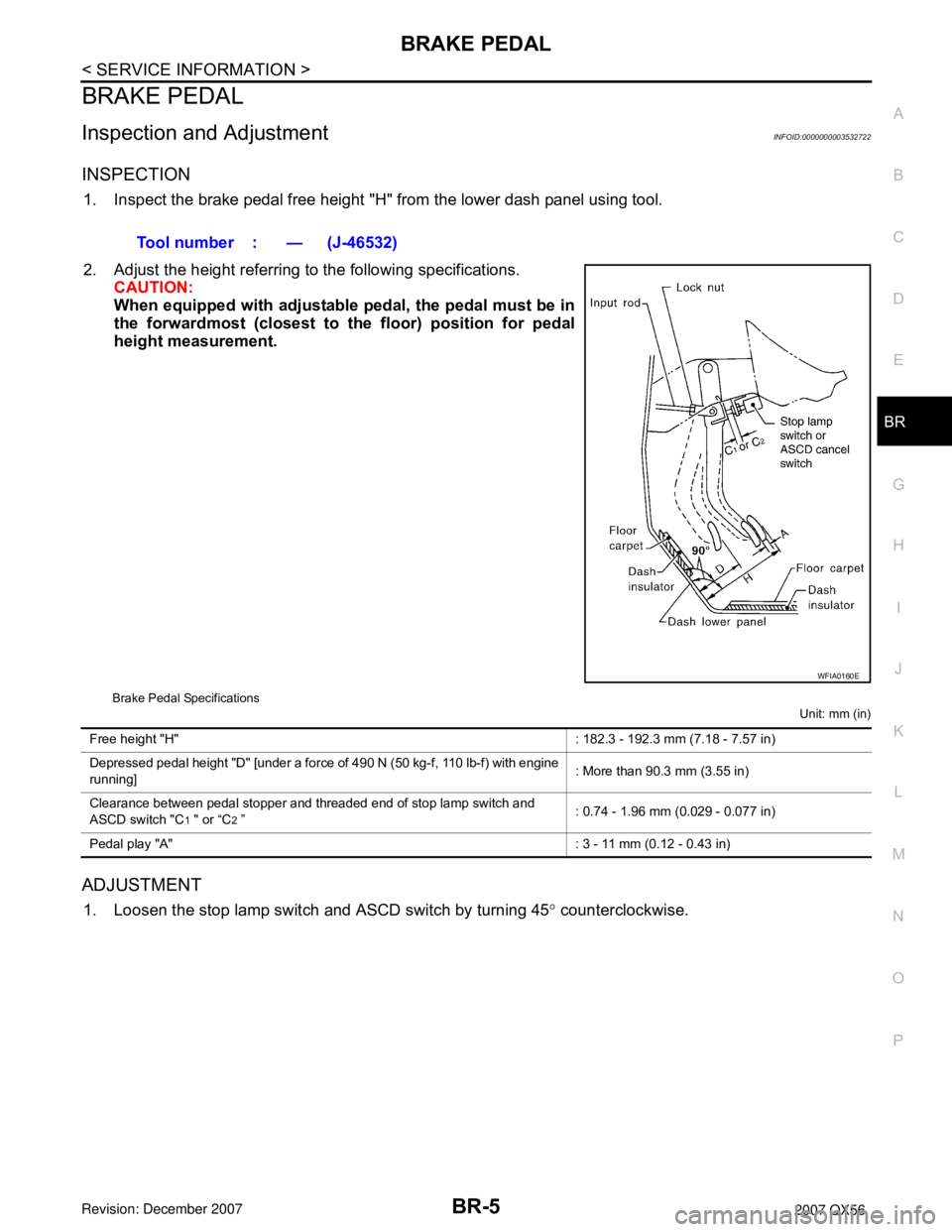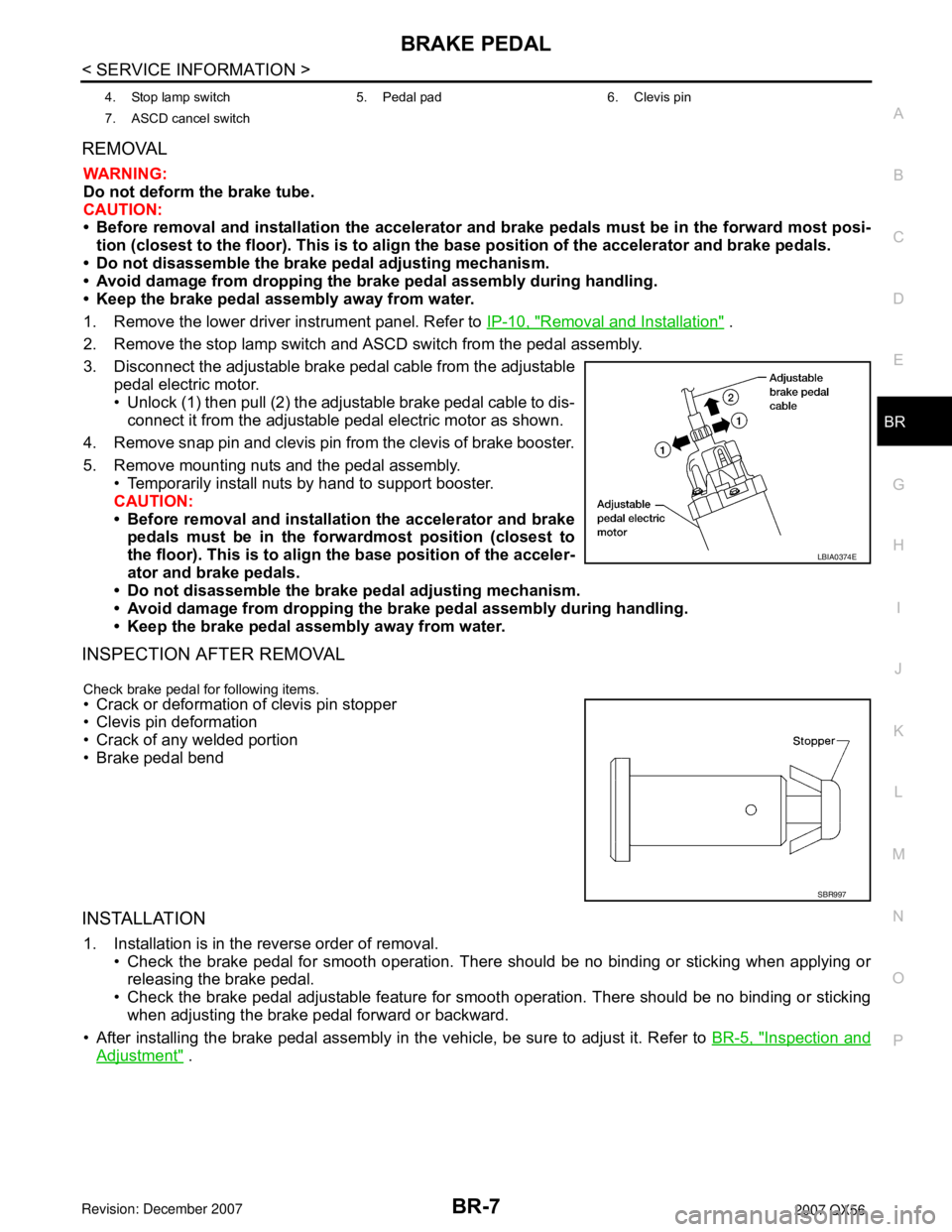brake INFINITI QX56 2007 Factory Service Manual
[x] Cancel search | Manufacturer: INFINITI, Model Year: 2007, Model line: QX56, Model: INFINITI QX56 2007Pages: 3061, PDF Size: 64.56 MB
Page 903 of 3061

BRAKE PEDAL
BR-5
< SERVICE INFORMATION >
C
D
E
G
H
I
J
K
L
MA
B
BR
N
O
P
BRAKE PEDAL
Inspection and AdjustmentINFOID:0000000003532722
INSPECTION
1. Inspect the brake pedal free height "H" from the lower dash panel using tool.
2. Adjust the height referring to the following specifications.
CAUTION:
When equipped with adjustable pedal, the pedal must be in
the forwardmost (closest to the floor) position for pedal
height measurement.
Brake Pedal Specifications
Unit: mm (in)
ADJUSTMENT
1. Loosen the stop lamp switch and ASCD switch by turning 45° counterclockwise. Tool number : — (J-46532)
WFIA0160E
Free height "H" : 182.3 - 192.3 mm (7.18 - 7.57 in)
Depressed pedal height "D" [under a force of 490 N (50 kg-f, 110 lb-f) with engine
running]: More than 90.3 mm (3.55 in)
Clearance between pedal stopper and threaded end of stop lamp switch and
ASCD switch "C
1 " or “C2 ”: 0.74 - 1.96 mm (0.029 - 0.077 in)
Pedal play "A" : 3 - 11 mm (0.12 - 0.43 in)
Page 904 of 3061

BR-6
< SERVICE INFORMATION >
BRAKE PEDAL
2. Loosen lock nut on the input rod, then turn input rod to adjust the
pedal to specified height. When finished adjusting, tighten lock
nut.
CAUTION:
Make sure that the screw portion of the end of input rod is
located inside the clevis.
3. With the pedal pulled up and held by hand, press the stop lamp
switch and the ASCD switch in until threaded ends contact pedal
arm.
4. With the threaded ends of the stop lamp switch and ASCD
switch contacting the pedal arm, turn the switches 45° clockwise
to lock in place.
CAUTION:
Make sure that the gap (C) between the rubber stops and
switch ends are within specification.
5. Check the pedal play.
CAUTION:
Make sure that the stop lamp goes off when the pedal is
released.
6. Start the engine and check the height of the brake pedal when
depressing it.
Removal and InstallationINFOID:0000000003532723
Lock nut : 18.6 N·m (1.9 kg-m, 14 ft-lb)
PFIA0436E
1. Brake pedal assembly 2. Snap pin 3. Clip
WFIA0232E
Page 905 of 3061

BRAKE PEDAL
BR-7
< SERVICE INFORMATION >
C
D
E
G
H
I
J
K
L
MA
B
BR
N
O
P
REMOVAL
WARNING:
Do not deform the brake tube.
CAUTION:
• Before removal and installation the accelerator and brake pedals must be in the forward most posi-
tion (closest to the floor). This is to align the base position of the accelerator and brake pedals.
• Do not disassemble the brake pedal adjusting mechanism.
• Avoid damage from dropping the brake pedal assembly during handling.
• Keep the brake pedal assembly away from water.
1. Remove the lower driver instrument panel. Refer to IP-10, "
Removal and Installation" .
2. Remove the stop lamp switch and ASCD switch from the pedal assembly.
3. Disconnect the adjustable brake pedal cable from the adjustable
pedal electric motor.
• Unlock (1) then pull (2) the adjustable brake pedal cable to dis-
connect it from the adjustable pedal electric motor as shown.
4. Remove snap pin and clevis pin from the clevis of brake booster.
5. Remove mounting nuts and the pedal assembly.
• Temporarily install nuts by hand to support booster.
CAUTION:
• Before removal and installation the accelerator and brake
pedals must be in the forwardmost position (closest to
the floor). This is to align the base position of the acceler-
ator and brake pedals.
• Do not disassemble the brake pedal adjusting mechanism.
• Avoid damage from dropping the brake pedal assembly during handling.
• Keep the brake pedal assembly away from water.
INSPECTION AFTER REMOVAL
Check brake pedal for following items.
• Crack or deformation of clevis pin stopper
• Clevis pin deformation
• Crack of any welded portion
• Brake pedal bend
INSTALLATION
1. Installation is in the reverse order of removal.
• Check the brake pedal for smooth operation. There should be no binding or sticking when applying or
releasing the brake pedal.
• Check the brake pedal adjustable feature for smooth operation. There should be no binding or sticking
when adjusting the brake pedal forward or backward.
• After installing the brake pedal assembly in the vehicle, be sure to adjust it. Refer to BR-5, "
Inspection and
Adjustment" .
4. Stop lamp switch 5. Pedal pad 6. Clevis pin
7. ASCD cancel switch
LBIA0374E
SBR997
Page 906 of 3061

BR-8
< SERVICE INFORMATION >
BRAKE FLUID
BRAKE FLUID
On Board InspectionINFOID:0000000003532724
LEVEL CHECK
• Make sure the fluid level in reservoir tank is within the standard
(between MAX and MIN lines).
• Visually check around reservoir tank for fluid leaks.
• If fluid level is excessively low, check brake system for leaks.
• If brake warning lamp remains illuminated after parking lever is
released, check brake system for fluid leakage.
Drain and RefillINFOID:0000000003532725
CAUTION:
• Refill with new brake fluid. Refer to MA-10
.
• Do not reuse drained brake fluid.
• Do not let brake fluid splash on the painted surfaces of the body. This might damage the paint, so
when splashing it, immediately wipe off the area and wash away with water.
• Before servicing, disconnect actuator connector or battery negative cable.
1. Connect a vinyl tube to each bleed valve.
2. Depress brake pedal, loosen each bleed valve, and gradually
remove brake fluid.
3. Make sure there is no foreign material in reservoir tank, and refill
with new brake fluid.
4. Rest foot on brake pedal. Loosen bleed valve. Slowly depress
pedal until it stops. Tighten bleed valve. Release brake pedal.
Repeat this process a few times, then pause to add new brake
fluid to master cylinder. Continue until new brake fluid flows out.
Bleed air from brake system. Refer to BR-8, "
Bleeding Brake
System" .
Bleeding Brake SystemINFOID:0000000003532726
CAUTION:
While bleeding, pay attention to master cylinder fluid level.
1. Turn ignition switch OFF and disconnect ABS actuator and electric unit (control unit) connector or battery
negative cable.
2. Connect a vinyl tube to the rear right bleed valve.
3. Fully depress brake pedal 4 to 5 times.
LFIA0225E
SBR419C
SBR995
Page 907 of 3061

BRAKE FLUID
BR-9
< SERVICE INFORMATION >
C
D
E
G
H
I
J
K
L
MA
B
BR
N
O
P
4. With brake pedal depressed, loosen bleed valve to let the air out, and then tighten it immediately.
5. Repeat steps 3 and 4 until no more air comes out.
6. Tighten bleed valve to the specified torque. Refer to BR-18, "
Component" (front disc brake), BR-24,
"Exploded View" (rear disc brake).
7. Repeat steps 2 through 6 at each wheel, with master cylinder reservoir tank filled at least half way, bleed
air in order from the front left, rear left, and front right bleed valves.
Page 908 of 3061

BR-10
< SERVICE INFORMATION >
BRAKE PIPING AND HOSE
BRAKE PIPING AND HOSE
Hydraulic CircuitINFOID:0000000003532727
CAUTION:
• All hoses and tubes must be free from excessive bending, twisting and pulling.
• Make sure there is no interference with other parts when turning steering both clockwise and coun-
terclockwise.
• The brake piping is an important safety part. If a brake fluid leak is detected, always disassemble the
parts. Replace applicable part with a new one, if necessary.
• Be careful not to splash brake fluid on painted areas; it way cause paint damage. If brake fluid is
splashed on painted areas, wash it away with water immediately.
• Do not bend or twist brake hose sharply, or strongly pull it.
• When removing components, cover connections so that no dirt, dust, or other foreign matter gets in.
• Refill with new brake fluid. Refer to MA-10
.
• Do not reuse drained brake fluid.
Removal and Installation of Front Brake HoseINFOID:0000000003532728
REMOVAL
1. Drain brake fluid. Refer to BR-8, "Drain and Refill" .
2. Using a flare nut wrench, remove brake tube from brake hose.
3. Remove lock plate and brake hose from bracket.
4. Remove union bolt and then remove brake hose from cylinder body.
INSTALLATION
1. Actuator 2. Master cylinder 3. Brake booster
4. Connector
WFIA0278E
Page 909 of 3061

BRAKE PIPING AND HOSE
BR-11
< SERVICE INFORMATION >
C
D
E
G
H
I
J
K
L
MA
B
BR
N
O
P
1. Install brake hose by aligning with the protrusion on cylinder
body, and tighten union bolt. Refer to BR-10, "
Hydraulic Circuit".
CAUTION:
Do not reuse copper washer.
2. Insert brake hose end through bracket, then secure it to bracket
with lock plate.
3. Install brake tube to brake hose, then tighten flare nut using a
flare nut wrench.
4. Refill brake fluid and bleed air. Refer to BR-8, "
Bleeding Brake
System" .
Removal and Installation of Rear Brake HoseINFOID:0000000003532729
REMOVAL
1. Drain brake fluid. Refer to BR-8, "Drain and Refill" .
2. Using a flare nut wrench, remove brake tube from brake hose.
3. Remove lock plate and brake hose from bracket.
4. Remove union bolt, and then remove brake hose from cylinder body.
INSTALLATION
1. Install brake hose by aligning with the protrusion on cylinder
body, and tighten union bolt. Refer to BR-10, "
Hydraulic Circuit".
CAUTION:
Do not reuse copper washers.
2. Insert brake hose end through bracket, then secure it to bracket
with lock plate.
3. Install brake tube to brake hose, then tighten flare nut to using a
flare nut wrench. Refer to BR-10, "
Hydraulic Circuit" .
4. Refill brake fluid and bleed air. Refer to BR-8, "
Bleeding Brake
System" .
LFIA0214E
LFIA0213E
LFIA0212E
LFIA0213E
Page 910 of 3061

BR-12
< SERVICE INFORMATION >
BRAKE PIPING AND HOSE
Inspection After Installation
INFOID:0000000003532730
CAUTION:
If a leak is detected at the connections, retighten it or, if necessary, replace the damaged part.
1. Check brake tubes and hose connections for fluid leaks, damage, twist, deformation, contact with other
parts, and loose connections. Replace any damage parts.
2. While depressing brake pedal under a force of 785 N (80 kg-f, 177 lb-f) with engine running for approxi-
mately 5 seconds, check for fluid leakage from each part.
Page 911 of 3061

BRAKE MASTER CYLINDER
BR-13
< SERVICE INFORMATION >
C
D
E
G
H
I
J
K
L
MA
B
BR
N
O
P
BRAKE MASTER CYLINDER
On Board InspectionINFOID:0000000003532731
LEAK INSPECTION
• Check for leaks at brake master cylinder to brake booster attachment point, reservoir tank, and brake tube
connections.
Removal and InstallationINFOID:0000000003532732
REMOVAL
CAUTION:
• Be careful not to splash brake fluid on painted areas; it may cause paint damage. If brake fluid is
splashed on painted areas, wash it away with water immediately.
• Before removing brake brake master cylinder, depress the brake pedal 5-6 times with the key OFF to
deplete vacuum in the booster.
1. Drain brake fluid. Refer to BR-8, "
Drain and Refill" .
2. Disconnect harness connectors for fluid level sensor and pressure sensors.
3. Using a flare nut wrench, disconnect brake tube from brake master cylinder.
4. Remove brake master cylinder mounting nuts, and master cylinder assembly.
INSTALLATION
• Installation is in the reverse order of removal.
1. Reservoir cap 2. Fluid level sensor 3. Grommet
4. Master cylinder sub-assembly 5. Front pressure sensor 6. Rear pressure sensor
7. Seal 8. Reservoir tank B. Brake fluid
R. Rubber grease
WFIA0450E
Page 912 of 3061

BR-14
< SERVICE INFORMATION >
BRAKE MASTER CYLINDER
• Refill brake fluid and bleed air. Refer to BR-8, "Bleeding Brake System".
CAUTION:
• Refill with new brake fluid. Refer to MA-10
.
• Do not reuse drained brake fluid.
• Adjust brake pedal. Refer to BR-5, "
Inspection and Adjustment" .
Disassembly and AssemblyINFOID:0000000003532733
DISASSEMBLY
CAUTION:
• Master cylinder cannot be disassembled.
• Remove reservoir tank only when absolutely necessary.
Pull reservoir tank off master cylinder sub-assembly, then remove grommets from master cylinder sub-assem-
bly body.
ASSEMBLY
CAUTION:
• Never use mineral oil such as kerosene, gasoline during the cleaning and assembly process.
• Do not drop parts. If a part is dropped, do not use it.
1. Apply brake fluid or rubber grease to new grommets, then insert into master cylinder sub-assembly. Refer
to GI-45
.
CAUTION:
Do not reuse grommet.
2. Install reservoir tank onto master cylinder sub-assembly.